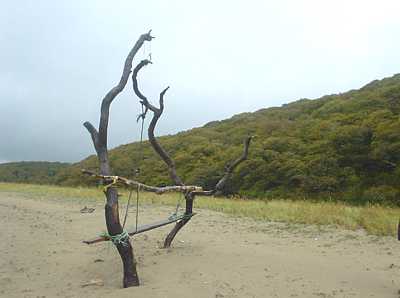Fishing equipment
Sea kayak fishing with rods and other equipment is a growth sport. It needs a stable kayak such as an ordinary sit-on-top. Here we're thinking about a very lightweight, compact kit that will easily fit into a long, thin sea kayak loaded for a camping trip. We're going to assume that your only experience of fish is in little frozen bricks from the supermarket.
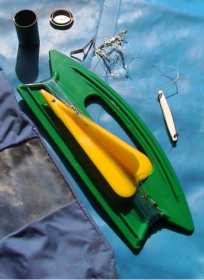
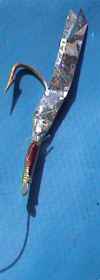 Most seaside fishing stores sell hand-line kits for boat fishing. That's a flat nylon spool with 30 yards of nylon monofilament line; a plastic paravane to take the hooks down while you're going along, with a small lead weight in case you prefer jigging the line up and down while stationary; and a set of feathers connected to the line with a swivel.
Most seaside fishing stores sell hand-line kits for boat fishing. That's a flat nylon spool with 30 yards of nylon monofilament line; a plastic paravane to take the hooks down while you're going along, with a small lead weight in case you prefer jigging the line up and down while stationary; and a set of feathers connected to the line with a swivel.
The feathers are six or eight hooks attached at 8-inch intervals to a 3-foot length of monofilament, with a short strip of reflective plastic foil for each hook. A 35 mm film container (remember film?) is good for keeping the hooks safe. You also need a sharp knife and a bag for your catch. If you're fishing from your kayak it's useful to have a nylon mesh bag, and a small plastic chopping board or tray to keep blood and scales off you.
It is possible to use a hand-line solo from a sea kayak 22 inches wide, but dangerous. It is not good if you accidentally capsize while dealing with a couple of struggling fish and get wrapped up in line and hooks. It's better to raft up with somebody or go stand on a rocky headland.
Having caught your fish, gut it as soon as you get to the beach. Cut open the stomach cavity in one line starting under the jaw, remove the guts and throw them back in the sea. Wash the fish, leave the skin on and cook. You can cut a green stick from a bush, impale the fish on it and arrange a few rocks to hold it at the right distance from an open fire; or fry both sides for just a minute or so in a little oil. When cooked, slice along the backbone and peel away the flesh so that you don't get the bones.
Camp fire equipment
Except in a real wilderness area it's best to take a stove for cooking, and light an open fire only if there's a good opportunity to do so without causing damage.
You don't necessarily need anything more than matches in several small watertight containers and/or a magnesium fire starter with cerium insert to make sparks. Fire-building is easier if you have a saw. For a small group, either a pruning saw with a rigid 8-inch blade that folds into handle or a 16-inch length of chain saw with a handle on each end. For a large group, a good-quality bow saw. If you plan on a beach barbecue, consider taking a stainless steel grille wrapped in an offcut of 3/8" foam sleeping pad.
Use driftwood or dead wood if it is available. Unless you are in a real wilderness area which gets very few visitors, don't break branches off trees. Make your fire on the beach so it does not damage vegetation or set fire to grass, heather or peat. Make it below the high tide line, so that the next high tide will wash away the remains. Bear in mind that the underside of a disposable barbecue gets hot enough to set fire to any wood or vegetation it stands on.
Caution - sparks will instantly burn small holes in kayaking clothing, and on a flint beach the pebbles may explode with a bang and a whizz of sharp fragments.
When the flames have died down leaving just glowing embers you can place the grille a few inches above the heat by putting the ends on piles of rocks. As any Boy/Girl Scout knows, or knew before we invented health & safety, you can bake small potatoes in the ashes. Wrap them in wet clay or aluminum foil and take them out before they get too charred.
If you plan to do all your cooking over an open fire, take some firelighter blocks unless you can be sure of good weather; a big frying pan with metal handle; and a billy can (a tall cooking pot with a lid and a wire handle so you can use a pole or branch to hang it over the fire).
Cooking equipment
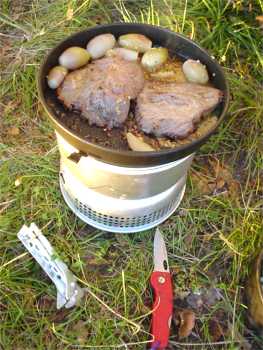 We mentioned campfires above. This is what most people take for cooking:
We mentioned campfires above. This is what most people take for cooking:
• Stove and fuel. Most kayakers use small, lightweight mountaineering stoves, and different people prefer different fuels. None of them should be used in a tent, mainly because they give off toxic exhaust gases.
Your editor loves alcohol stoves like the Trangia in the photo. They're cheap, tough, reliable and effective. They burn 90% ethyl alcohol, also known as methylated spirits, denatured alcohol or burning alcohol. Cooking with an alcohol stove takes a little longer, you have to carry a little more fuel, and you may need to bend a Trangia's aluminum cooking pans a little to get the stove through a kayak hatch. On the other hand a Trangia is light, has a wide base for stability, no moving parts to go wrong, and 4 pints of fuel should be enough for a week. If the fuel leaks onto you or your possessions it will cause no real harm. If an alcohol stove falls over while burning it won't explode or seriously injure you. If you accidentally ignite the air-vapor mix in your fuel bottle, with alcohol the explosion will probably do no more than burn your eyebrows off. Downside? The outside of the cooking pan gets sooty; at very low temperatures you may have to spend a minute with your box of matches warming up the alcohol until it produces a vapor that will burn; and in some parts of the world with a problem of alcohol abuse there are legal restrictions on sale of the fuel.
Liquefied gas (butane or propane) is a clean, low odor fuel for camping stoves, and it's very popular. The fuel gives off a lot of heat for its weight. If you spill the fuel, it evaporates cleanly. Downside? You may be a long way from a store that sells replacement gas cartridges or refilled gas cylinders. Butane stoves don't work at temperatures much below 5 degrees centigrade. Butane and propane can both cause serious injury if there's a small leak. They're heavier than air, and they can collect in a confined space such as a tent where the gas/air mix will burn or explode if accidentally ignited.
The lightest stove/fuel combinations burn gasoline from a pressurized tank. Gasoline is a compact fuel that burns with a very hot flame, ideal for boiling up large amounts of water or for melting snow. A gasoline stove has the power to heat a wok for a stir fry, or heat a large volume of water so you could use a pressure cooker for group cooking. You can buy gas almost anywhere, and multi-fuel stoves are available which will burn anything from aviation spirit to cooking oil if necessary. Downside? The stoves have a lot of small parts that can clog or leak. Gas has a very strong and persistent odor, and it dissolves many plastics, so spilling it on your sleeping bag or drysuit could be a disaster. Gasoline is also very hazardous - spilled gas burns very hot, and gasoline vapor is highly explosive when mixed with air.
Some campers love camping stoves that burn kerosene / liquid paraffin like the original Optimus range. They're OK, but the stoves have a lot of small parts, the fuel smells bad if spilt and it can be hard to find a store that sells it. Better for a base camp than for carrying in a kayak, maybe.
• Cooking pots with lids and jackets. Any camping or military surplus store has sets of aluminum pans. See Retail Outlets. Trangia stoves come with a set of pans, but if you have a big appetite you may need to take an extra pan. Non-stick pans are distinctly more convenient than plain ones but you'll need a wooden spoon so as not to scratch the coating. One pan-handle for a Trangia is never enough, so it is worth buying a second one from your camping store and extra lids if necessary. If you have time, make an insulating jacket out of 3/8" foam sleeping pad for each of your cooking pots. It is the easiest way to have everything hot and ready at the same time.
Also:
• Matches in several small waterproof containers
• Small sharp knife
• Chopping board or (preferably) a plastic tray with raised edges
• Bio-degradable dish washing liquid such as Dr Bronner's or Ecover. See Leave No Trace Ethics.
• Nylon scouring pad, can opener, spoons, insulated mugs
• Strong garbage bags
Water & food
Water
In Nelson's navy, the allowance of water for sailors was 8 pints (4.5 liters) per day. That had to be enough for drinking while doing a lot of hard physical work, and shaving.
We also need water for cooking and washing. To stay in top condition we need 3.5 pints (women) to 4.5 pints (men) per day. You may need to drink twice that to stay properly hydrated when doing physical activity in hot weather. A good test is the color of your urine. If it is colorless or very pale yellow you are drinking enough. A good basic allowance for an expedition is 10 to 12 pints per person per day.
12 pints weighs more than 15 lbs so don't carry more than you have to. Water for a trip lasting four days could weigh more than your kayak. If you are passing a settlement most days you can get clean water from a faucet. In the Pacific northwest you can probably get clean water from rivers and streams although it makes sense to filter or boil it so you don't get diarrhea from giardia or other organisms.
You can't drink sea water, and if you wash in it you'll find that soap won't lather and you'll be left feeling damp and sticky. If you're going along the coast of a sparsely-populated mountainous area such as the Pacific northwest you can probably rely on river water. Water from steep, tumbling, clear little mountain streams is usually safe to drink as long as there's no village upstream. Whitewater kayakers accidentally drink quite a lot of river water without ill effects because it comes straight out of the ground or a glacier, whitewater is highly oxygenated, and harmful microbes generally don't like oxygen. The Giardia and Cryptosporidium parasites are widespread in waterways in North America and are present throughout Europe, including Britain and Scandinavia. They both dislike fast-flowing water. However it makes sense to filter and boil any stream water because diarrhea is no fun on a sea kayak trip. Water from slow-moving mature rivers in areas of intensive agriculture is not likely to be good for drinking even if there is no town upstream, although drinking some should be OK if you treat it with a pre-filter and filter and then boil it for at least one minute. In tropical areas, fresh water very often contains waterborne parasites which can seriously harm your health, but you can easily do like the locals and buy bottled water.
If you expect to need a filter, get a good one which can rapidly produce a couple of pints of drinking water, having removed chemicals, bacteria and virus-sized micro-organisms. So that your expensive filter does not rapidly get clogged up, it is a good idea also to have a large pre-filter. This is a waterproof bag with an outlet on the bottom. Fill it with water, hang it up and it will sieve out solids such as mud and tiny bits of vegetation.
Camp food
It's easy to eat well even if you leave at home everything that's perishable, heavy or takes a long time to cook. Fresh air and exercise really give you an appetite, especially for starchy carbohydrates and sweet things. The amount depends on the distance you cover each day, the wind and the temperature but on a multi-day expedition you are likely to want twice as many calories. Say 4000 - 5000 calories a day rather than the average 2000 - 2500 calories.
It is possible to survive on cheese sandwiches, soup poured over noodles, canned stew (urgh), cookies and supermarket cake but how about fresh bacon, egg & fried onion rolls for breakfast, with real coffee; hot soup, mashed potato and cheese for lunch; and in the evening a barbecue of marinaded chops with a rice, bean & tomato salad and a bottle of wine?
For the gold standard in kayak catering, consider the supplies taken by a group of nine French kayakers on a 15 day trip to the Hebrides. They had no refrigeration, no cooler, and seldom saw a foodstore. They took a little dehydrated food, in particular instant soup and sachets of dried potato, but also dried ham, dried sausage, dried mushrooms, canned tuna and sardines, fresh eggs, Parmesan, Emmenthal and two other sorts of cheese, fresh garlic, onions, scallions, carrots, green peppers, lemons, apples and oranges. All of these will keep for weeks at room temperature. They also took three sorts of pâté, butter (salted butter keeps for a long time at room temperature), olive oil, salt, peppercorns and a grinder, dried herbs, spices, stock cubes, mustard, mayonnaise, capers, tomato paste, noodles, couscous, rice, pasta, bulgur wheat, soy TVP and quick-cook lentils.
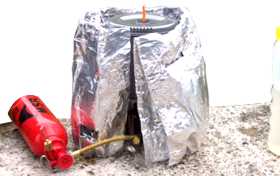 They took three little MSR stoves, each with its pressurized fuel bottle and a home-made aluminum foil windshield.
They took three little MSR stoves, each with its pressurized fuel bottle and a home-made aluminum foil windshield.
And not only the usual aluminum cooking pots but also a measuring pitcher, large heavy frying pan, pressure cooker, ladle, wooden spoons, peeler, grater, bread bag, an oyster knife and one winkle-pick per person for small shellfish like whelks and winkles. Outstanding.
For breakfast, they had cereals, bread with honey or jam, Nutella crêpes and coffee. A Scottish alternative might be a mug of tea and a bowl of hot, creamy porridge with a handful of raisins and a dash of honey if required.
They carried a range of snacks to eat while on the water, including cereal bars, raisins, peanuts, candy bars, dried fruit, fresh carrots and apples. For trips in cool weather, a home-made fruit cake and an apple always go down well.
For lunch, they made sandwiches with bread, cheese and/ or pâté, and ate them with tomatoes, apples and soup from a vacuum flask. When the bread runs out, you can use flour and water to make fresh bannock, drop-scones or pancakes in a frying pan. We recommend risi e bisi. The camping version is rice fried in oil before being cooked in water with a vegetable stock cube, dried peas, chopped onion and turmeric. In cool weather it keeps for two or three days without refrigeration and is very acceptable cold at lunchtime, especially with grated cheese.
For pre-dinner aperitif and nibbles the French kayakers took along several bottles (Calvados, Pernod, etc) and a selection of olives, nuts, cocktail snacks and dry sausage. For the dinner itself, they usually had a base of pasta or rice with sauces cooked from fresh (basic fried onion, tomato and herb sauce, right up to cordon bleu) with dry meat, canned fish or cheese; cold salads of pasta or rice with oil, fresh lemon juice and vegetables; clams and mussels from the beach; and fish they caught while kayaking.
If you are using one-burner camp stove(s) you need things that cook quickly, and some way to keep one pot hot while another is cooking. Lids and insulating jackets are good. We avoid any rice or pasta that needs 20 minutes of cooking. Bulgur wheat, vermicelli and noodles are very handy substitutes - just add boiling water and leave on one side while you cook something else. It takes a long time and much fuel to cook carrots but fresh carrots are very nice just grated and served with freshly-squeezed lemon or orange juice.
If you are going to be independent of stores for a long time you will want to minimize both weight and bulk. Don't take much fresh milk, if any. Milk powder or cans of condensed milk are good. Fresh potatoes are out, because they are 80% water. Sachets of dehydrated potato powder are great if you have just arrived at a beach after a long, hard day's kayaking on a cold day. Boil up some water, mix with powdered potato and ten seconds later you can eat it with butter and maybe some nutmeg.
You won't want to carry too many cans, jars, bottles or pots that can squash or break. Almost certainly you will be able to buy some fresh food from local stores as you go along.
We avoid canned vegetables and stews, because they are heavy. Supermarkets and outdoor stores sell some excellent dehydrated food, from quite a nice Chicken Supreme to instant soups for tea-break. If a dehydrated meal turns out to be disappointing you can add butter, dried garlic granules, dried onion, dried peas, tomato paste or Parmesan.
If you're planning to get a lot of exercise in cool weather, you will need plenty of fat so take butter and medium-fat cheese. In cool weather, both will keep for weeks at room temperature.
If you want real coffee there's no need for any equipment. Just put a spoonful of ground coffee in your mug, add nearly-boiling water, milk, and remember to stop drinking before you reach the lumpy bit at the bottom.
Beer is heavy and bulky but a bottle of wine (whiskey? cider? Calvados? vermouth?) or a three-liter wine box can easily be fitted into a kayak.
One way to get fresh food a long way from a shop is to collect it. You may have paid to eat wild food already - there are professional foragers who supply expensive restaurants. The seashore is one of the best places for wild food. Samphire's pretty grim stuff but there are fish, clams, mussels (Mytilus edulis and other species are about a thousand times nicer fresh than pre-cooked in a plastic sachet, check they're alive when taken and avoid red tides), various sorts of edible seaweed, a dozen safe varieties of mushroom, autumn fruits, nuts and berries, wild garlic and dandelions (Taraxacum officinale, nice in salad but a diuretic). The fresh young tops of stinging nettles Urtica dioica make a truly great soup and can also be steamed and eaten as a vegetable like spinach.
Stowing equipment in a sea kayak
Although kayaks usually have two watertight compartments they are seldom really watertight, and anyway they may leak if your kayak gets damaged during the trip. It's worth putting all dry equipment in waterproof boxes or dry-bags, preferably transparent. You can get expensive 99.9% waterproof boxes from a specialist kayak store, or cheap 99% waterproof ones from your local supermarket.
Stowage of sleeping bags is a problem we discuss here.
Try to avoid carrying food in the same compartment, or even the same kayak, as a repair kit containing liquid polyester resin. It makes everything taste of styrene.
Don't put anything heavy in the extreme ends of a kayak because it will likely misbehave in waves. Try to keep the heavy objects near the center of the kayak, mostly just behind your seat and some just in front of your footrest.
After you set off, you may have to re-pack your kayak after a short distance, to improve its handling. Many kayaks behave best in waves and crosswinds if the rear end is slightly heavier than the front.
As far as possible, safety equipment should not be stowed anywhere which will force you to take off your sprayskirt or a deck hatch at sea. You can carry a VHF radio in your PDF pocket; and your spare paddle and a portable pump under your decklines. There are various places you could keep a rescue stirrup, flares and a patch kit for a leaking kayak. Some people put them in a deck bag, some in a fanny pack, and some in a large lightweight plastic cylinder carried on the rear deck. If you have a day hatch opening into a very small watertight compartment just behind the seat or between your knees, it makes a good place for items of this sort. If you have a paddle float you can keep it in your cockpit attached to the seat or backrest.

 Most seaside fishing stores sell hand-line kits for boat fishing. That's a flat nylon spool with 30 yards of nylon monofilament line; a plastic paravane to take the hooks down while you're going along, with a small lead weight in case you prefer jigging the line up and down while stationary; and a set of feathers connected to the line with a swivel.
Most seaside fishing stores sell hand-line kits for boat fishing. That's a flat nylon spool with 30 yards of nylon monofilament line; a plastic paravane to take the hooks down while you're going along, with a small lead weight in case you prefer jigging the line up and down while stationary; and a set of feathers connected to the line with a swivel. 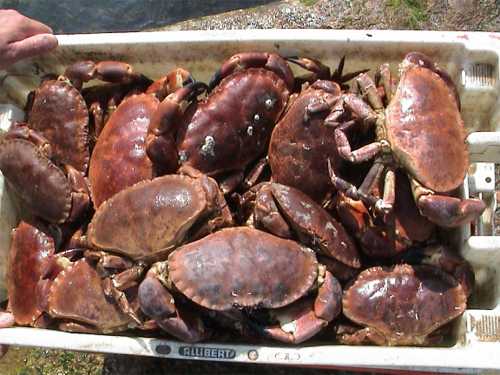
 We mentioned campfires above. This is what most people take for cooking:
We mentioned campfires above. This is what most people take for cooking:  They took three little MSR stoves, each with its pressurized fuel bottle and a home-made aluminum foil windshield.
They took three little MSR stoves, each with its pressurized fuel bottle and a home-made aluminum foil windshield. 